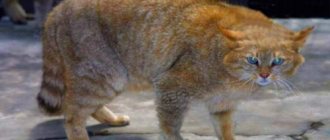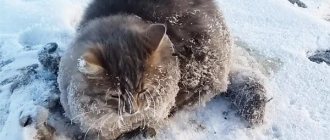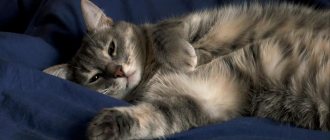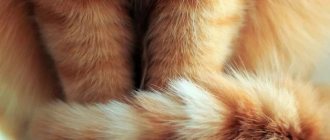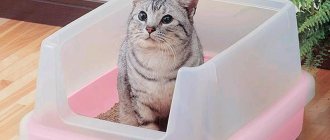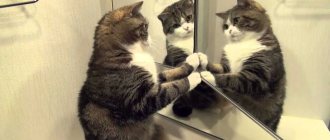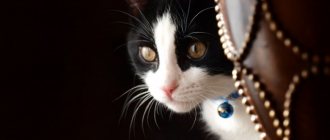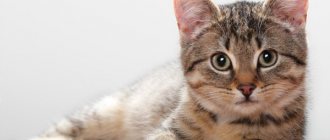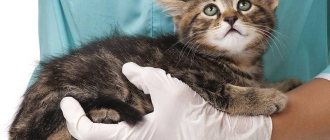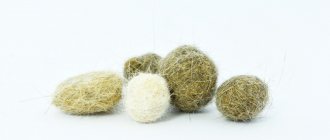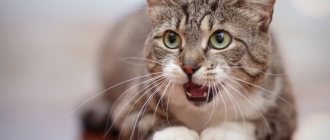Home / Other animals / Why is the cat’s lower jaw shaking?
It’s hard not to notice when a cat’s lower jaw is shaking, even if you spend little time at home. This symptom is frightening and immediately noticeable to the owner. The reason for this phenomenon can have a different nature of origin, ranging from injuries received during games or fights with other animals, and ending with dental problems, from which animals over the age of 12 years suffer the most. You shouldn’t ignore even a slight trembling, as a timely visit to the doctor can cost your pet’s life!
Most of all, you should be wary of cases that are associated with kittens aged 2-4 months. A shaky lower jaw may be the first sign of epilepsy, which is considered a genetic, incurable disease. In other cases, the following possible options cannot be excluded:
- Injury. Any unsuccessful landing after a fall, even from a low height, can lead to serious injuries to the head and limbs. If a cat's jaw shakes after a blow or bruise, then it is necessary to show the animal to a veterinarian to rule out cracks and fractures. This symptom can also be observed with subluxations and dislocations of the lower jaw. At the same time, the animal may have strong salivation, the mouth may not close completely, the tongue may fall out, or the chin may swell. Jaw dislocations in animals are corrected in a veterinary clinic according to the same procedure. Much will depend on the timeliness of visiting a doctor, since fresh dislocations can be reduced quite easily without the use of anesthesia. Old injuries have to be repaired with anesthesia and painkillers, which are not always well tolerated by older pets. Some owners try to straighten the dislocation on their own, but without experience and confidence, this manipulation can result in terrible pain for the cat.
- Foreign body. If something sticks into the mucous membrane of the mouth or under the skin on the chin, then there is a high probability of developing a suppurative process. Before visible symptoms appear, you may notice how the cat twitches its lower jaw, trying to get rid of the source of discomfort. And the cause of all the troubles can lie even in a small cactus needle, which is often found on the windowsill of many housewives. Much attention is also paid to the mucous membrane inside the mouth, since leftover food or other objects that the animal plays with (wooden chips, pieces of plastic from toys, etc.) can stick into it. Typical signs of a foreign body getting into the gums or inside the cheeks may be redness, bleeding and increased salivation. You will be lucky if the pet does not resist during examination and you can quickly detect and remove the source of irritation. Then all that remains is to thoroughly rinse the wound with a chlorhexidine solution and hope that no infection has gotten inside and there will be no inflammation. If you yourself were unable to detect or remove the source of discomfort, then it is better not to wait for the animal’s condition to worsen (the development of an abscess and complete refusal to eat), but to immediately see a veterinarian.
- Abscess. If an abscess forms on the chin, then there is a high probability that it will cause the cat significant discomfort not only during meals, but also at rest. Because of this, the pet may shake its lower jaw, rub against hard objects, or scratch the area where the abscess is located with its paws. Many abscesses are accompanied not only by great swelling, but also by terrible pain when touched. The size of ulcers can reach a walnut. They are hard to the touch, as they are filled with purulent masses. Under good circumstances, the abscess breaks out on its own; the owner only needs to treat the resulting wound with an antiseptic solution. Less often you have to seek help from a veterinarian, who, using a special scalpel, will open the abscess and clean the cavity of pus and blood. If necessary, the wound is drained, and anti-inflammatory and healing ointments are prescribed. On average, abscesses mature and heal within 7-10 days.
- Tumors. Most often, squamous cell carcinoma and sarcoma develop in the part of the body that interests us, which are difficult to treat, especially in adults. Therefore, if an adult cat’s lower jaw is shaking, you need to carefully examine it for the presence of tumors. In some cases, lumps can only be felt, since they are localized under the skin and are not very noticeable. The diagnosis can only be confirmed with a biopsy. Depending on the malignancy and stage of the tumor, appropriate treatment is selected. You need to be prepared for the fact that the treatment will be palliative, since with sarcomas in the muzzle area the prognosis is rarely favorable.
Finally, I would like to remind you about dentistry (tooth cyst, tooth root abscess), which can also cause problems with the jaw in cats.
Most of all, you should be wary of cases that are associated with kittens aged 2-4 months. A shaky lower jaw may be the first sign of epilepsy, which is considered a genetic, incurable disease. In other cases, the following possible options cannot be excluded:
Only registered users have the ability to start new topics. Register and log in to the site by entering your username and password on the right side of the window, and you can start a new topic.
Before visiting the forum, read the topic: “How to properly consult a veterinarian,” as well as the list of answers to frequently asked questions, this will help you save your time and get an answer to your question faster. Pay special attention to the document: Symptoms of animal diseases. Perhaps in your situation you cannot expect an answer on the forum, but you need to urgently call a doctor or take the animal to a veterinary clinic!
We recommend reading: Cutaneous Infection with Plague
Before joining the forum, read the following sections, this will help save your time and quickly get an answer to your question:
Attention! Pay special attention to the document “Symptoms of Animal Diseases”. Perhaps in your situation you cannot expect an answer on the forum, but you need to urgently call a doctor or take the animal to a veterinary clinic!
Before joining the forum, read the following sections, this will help save your time and quickly get an answer to your question:
The cat is 10 months old, weight 4500. Outbred, we live in the village. Recently I had a couple of fights with my neighbor’s adult cats, after which I noticed that his lower jaw was periodically twitching, it looked like an unconscious twitching like a nervous tic. The jaw twitches down, as if the mouth is opening slightly, twitches quickly several times, as if with a tic, then stops and the cat closes its mouth. The twitching sounds resemble quiet smacking. More twitching when starting to eat. Twitches many times a day. Appetite is good. Sleep too, during sleep this symptom is not visible. There are no other symptoms. They examined the cat themselves, felt the jaw, looked into the mouth and throat, there is nothing foreign there, the cat allows itself to be touched, even pressing on the neck, head, jaws, it does not hurt him, the jaws close normally, the bite appears to be normal upon examination. What could it be? Could this be a tic from fear? He hasn't fought before. We ourselves think that it is somehow connected with the fight. There is no veterinarian here and taking him there is very difficult. Is there a chance that this is nerve-wracking and might go away on its own? The cat eats, but the symptom gives him anxiety, he began to lie down more, and lost a little weight; he got into a fight a week ago.
Depending on the factors causing increased salivation, this condition may differ significantly in external signs.
- We most often see drooling due to nausea in cats. Drooling in such cases can begin quite abruptly and end with gagging. The animal begins to actively smack its lips with saliva, may meow loudly, the saliva becomes viscous and viscous, often hanging from the lips in the form of foam. The cat tries to shake its head, shaking off saliva. With chronic nausea, hypersalivation may not be so pronounced.
- With pathologies associated with diseases of the oral cavity and salivary glands, we usually see saliva dripping from the chin or soaking the fur around the cat’s mouth and chest. Often the saliva acquires an unpleasant odor and an admixture of blood or pus.
The cat's lower jaw twitches
Veterinarians note that a cat’s jaw may tremble due to minor physical damage or serious diseases of a viral or infectious nature. The most dangerous cause is rabies, which is difficult to diagnose. If your cat's jaw begins to shake, then you need to take her to the doctor, since it is impossible to make an accurate diagnosis at home.
Death throes
The cause of seizures in cats can be the approach of death. Agony, or the dying state, is accompanied by acute oxygen starvation. Hypoxia indicates decreased heart rate and impaired breathing. Muscles suffering from a lack of oxygen begin to twitch intensely. At this moment the animal experiences severe pain. Typically, due to pharyngeal paralysis, cats do not make any sounds. Pain syndrome is indicated by:
- dilated pupils;
- intermittent breathing;
- complete lack of physical activity;
- lack of response to external stimuli.
Why does my jaw tremble?
If a negative symptom occurs, veterinarians recommend conducting a blood test and scraping the oral mucosa to rule out viruses and infections. Some diseases can be transmitted to people.
Veterinarians focus the attention of cat owners on the fact that it is impossible to make a diagnosis based on one symptom - jaw tremor; a full examination and medical history is required. In the clinic, the pet needs to examine the oral cavity to identify physical damage, wounds and inflammatory processes. You may need to undergo an x-ray examination, as well as a biochemical blood test. The most common reasons for shaking the lower or upper jaw include the following diseases:
- calicivirus;
- rabies;
- neurotic disorder;
- inflammation of the tonsils;
- physical damage to gums or bones;
- tartar;
- formation of ulcers in the mouth;
- inflammatory process in the gums;
- chemical burn of the oral mucosa;
- consequences of anesthesia.
Return to contents
How does it manifest?
Most often, a pet does not jerk its head and mouth all the time, but with equal frequency. The tremors may resemble a seizure attack. Depending on the type of disease, the pet exhibits the following negative symptoms:
- general lethargy;
- refusal of food;
- increased salivation;
- deterioration of thought processes;
- pain in the jaw area;
- bleeding from the gums;
- chills;
- local increase in temperature in the muzzle area;
- deterioration in fur quality;
- inflammation with the formation of pus in the eyes;
- formation of ulcers in the mouth and nose;
- deterioration of coordination.
Return to contents
Treatment options
Veterinarians note that therapeutic procedures vary, depending on the reasons why the cat’s face is cramped. If the jaw twitches due to injury, then the pet can be given injections of painkillers, for example, Novocaine or non-steroidal anti-inflammatory drugs. Physical manipulation may be required to return the bones to their anatomically correct position.
After recovery, the fluffy dog must be vaccinated against rabies.
Once a pet has contracted rabies, there is no cure and it will end in the pet's death. The disease can be transmitted to humans, therefore, at the slightest suspicion of infection, isolation is indicated for the cat. There is no point in vaccinating a cat if it is already presumably sick. However, if the pet is confirmed to have another diagnosis, veterinarians focus on mandatory vaccination 2 weeks after stopping the medication. A pet weakened due to illness cannot be vaccinated.
The particular danger of rabies, one of the symptoms of which is jaw tremor, is that it cannot be detected in a living cat by analysis.
If a cat has burnt mucous membranes of the oral cavity and an inflammatory process is observed, then quarantine is indicated for the pet. Among traditional methods, to reduce inflammation, veterinarians recommend giving 1-2 ml of olive oil, which should be dripped onto the root of the tongue. If an infectious or viral disease is suspected, isolation of the animal is also indicated, and veterinarians recommend vaccinating other pets living in the house.
Additionally, the cat is prescribed vitamins through injections into the drawn-out withers. The procedure can be carried out at home, but you need to thoroughly disinfect the fur and needle with alcohol or hydrogen peroxide. Sometimes diuretics may be indicated for your pet to speed up recovery. Veterinarians prohibit self-prescription of medications and the use of drugs to treat people.
source
Teeth grinding while eating
Most often, a cat grinds his teeth when he eats. At the same time, he may show concern: meow. rub its face with its paws, spit out food.
The cat creaks while eating (cat grinding his teeth) for the following reasons:
- subluxation of the jaw;
- worms;
- periodontal disease;
- tartar;
- liver problems;
- diseased kidneys;
- uremic gastritis;
- rabies.
The chewing function includes several stages:
- capturing food with fangs, lips and tongue;
- directing it to the surface of the molars;
- lateral movements of the lower jaw.
The degree of compression, the nature of the movement of the lower jaw, and the condition of the periodontal disease in their pathology cause the teeth to creak.
Subluxation of the lower jaw
When the jaw is subluxated, the cat clicks its teeth when eating or drinking. Reason: the age of the animal or an unsuccessful landing after a jump. Cats can fall and suffer severe head injuries. One of the consequences of the blow may be subluxation of the lower jaw, which leads to loose closure of the dentition. In older cats, subluxation may occur due to a strong yawn. Weakened ligaments and jaw muscles are unable to hold the jaw in the same position. Teeth grind when trying to close jaws.
A dislocated lower jaw must be corrected by a specialist. Owners of older cats have to learn this method due to frequent recurrences of subluxations. The reduction scheme consists of several manipulations:
- inserting a stick between the roots;
- bringing the upper and lower jaws closer together;
- abduction of the lower jaw until it clicks.
The procedure is painful; the pet needs to have the submandibular nerves numbed.
Infection with worms
Infection with worms leads to intestinal bloating and pain, which the animal tries to drown out by intense chewing. Severe pain of any etiology causes a strong reflex clenching of the jaws, from which the teeth begin to grind. Subsequently, constipation, diarrhea, vomiting appear, and appetite decreases. The animal loses weight, its coat loses its shine, and its immunity decreases. Treatment for helminths involves destroying the parasites. Medicines are available in oral form or externally (drops for application to the skin).
We recommend reading: How to Treat Diarrhea in a Dachshund Puppy
Drugs should be given to the animal for prevention in any case. Cats that are not allowed outside can become infected with worm eggs brought from the street on clothes and shoes. Without following sanitary rules, the fight against helminths will be ineffective. It is necessary to wash and disinfect food and water bowls and trays. Contact with stray animals is a source of infection.
Dental pathologies
With periodontal disease, the periodontal tissues are inflamed, the neck of the tooth is exposed, and the attachment of the tooth in the gum is weakened. When eating, teeth become loose and their location changes. The surfaces of the teeth rub against each other and creak. If several teeth are severely affected by periodontal disease, they are removed under general anesthesia. To diagnose the disease, X-ray and visual examinations are performed. Teeth grind in the final stages of pathology, when bone tissue begins to deteriorate. Clenching of the jaws leads to uneven load, resulting in the cat creaking loudly while chewing.
Tartar at the junction of the gum and the base of the tooth can interfere with chewing, which is accompanied by a characteristic sound when teeth grind. The animal tries to chew on the side where there is no tartar. It is impossible to remove tartar at home: this requires an ultrasonic unit.
Diseases of internal organs
A cat grinds its teeth if the liver and kidneys cannot cope with their function. Bile acids and urates (uric acid salts) enter the oral cavity through the bloodstream. Bile breakdown products cause irritation of soft tissues. They become inflamed and begin to itch. The cat tries to fight the itching of the gums by squeezing them, causing the teeth to grind. An additional symptom of liver disease is vomiting while eating. Urea salts destroy tooth enamel. It loses its smoothness and becomes lumpy. The deformed surfaces of the teeth creak while eating.
The process of tooth decay occurs in a similar way with uremic gastritis. Its cause is chronic renal failure. The mucous membrane of the stomach becomes inflamed, resulting in increased production of hydrochloric acid. The valve between the stomach and esophagus is disrupted. Reflux occurs (reverse movement), as a result of which stomach contents enter the oral cavity, destroying the enamel.
Treatment of uremic gastritis should be aimed at renal therapy. To relieve symptoms, a low-protein diet with sufficient boiled water is recommended for the cat. Drug treatment is prescribed by a veterinarian after examining the cat’s kidneys and stomach.
Additional signs of uremic gastritis at the initial stage are:
- lethargy;
- decreased appetite;
- frequent urination;
- pungent odor from the mouth.
An accurate diagnosis can be made after a biochemical blood test, ultrasound of the kidneys and stomach.
Rabies
Grinding of your cat's teeth while eating may be one of the symptoms of rabies. The chewing process becomes painful. The animal eats slowly due to difficulty moving the lower jaw. Empty chewing movements cause grinding of rubbing dental surfaces (teeth grinding). There is no cure for rabies. The only way to avoid the disease is regular vaccination. If rabies is suspected, when teeth grinding is accompanied by increasing aggressiveness or apathy, the animal is isolated for 2-3 weeks for observation.
If the diagnosis is confirmed, the cat dies within one to two weeks. For a kitten, this period is reduced to 3-5 days. It is necessary to do an examination of the animal's cerebrospinal fluid. The owner will have to receive 7 anti-rabies injections within 6 months. Otherwise, he faces an incurable dangerous disease.
Trembling (tremor) in cats
The question of why a cat trembles worries many breeders. Although this phenomenon occurs frequently, it causes concern among breeders.
Trembling (tremor) is a convulsive contraction of the muscles of an animal, shaking or shuddering of the body or its parts. Trembling can appear suddenly and spread both to the entire body and to individual parts of it.
Tremor is not always a sign of pathology or a serious illness. Often its reason lies on the surface. Typically, physiological twitching occurs in any healthy cat and should not be a cause for concern.
There is also idiopathic tremors, that is, trembling of the animal, the causes of which cannot be determined.
Causes of trembling in cats
The shaking can be small and unnoticeable, especially in furry breeds, but it can be easily felt by placing your hand on the animal. Tremors can also be large and visible to the naked eye.
The scientific term tremor is used to define shaking. Tremors are defined as rapid and rhythmic movements that are caused by muscle contractions. Trembling can be classified according to several criteria:
- in terms of speed, shaking can be fast and slow;
- by localization, tremor of the animal’s head, limbs, croup and generalized tremor are distinguished;
- By severity, it is customary to distinguish between mild tremor, which does not interfere with the animal’s eating, drinking and leading an active lifestyle, and severe, in which case independent movement and eating are difficult for the cat.
The shaking may occur when you are at rest (resting tremor) and disappear when you move or try to make a precise movement. Limbs may tremble when the animal tries to hold them in a certain position.
As mentioned above, not all trembling is a sign of illness. There are enough reasons for physiological tremors and they are all involuntary rhythmic muscle contractions that are associated with mechanisms for regulating the state of the animal and are classified as physiological tremors. Experts identify the following causes of physiological tremors:
- Cold shivering is a thermoregulatory mechanism for physically protecting the animal’s body from hypothermia. As soon as the temperature becomes uncomfortable and even dangerously low for the animal, its body begins to tremble slightly. This allows you to quickly provide heat production and save the life of the animal. If your pet is freezing, you need to either dress it or increase the temperature in the room where it is kept. Because this mechanism is effective up to a certain limit. The cat may become hypothermic and get sick.
- Emotional experiences of a high degree (fear, joy). Under the influence of events that frighten a cat, its body, like the human body, secretes certain hormones, under the influence of which trembling and chills begin. Joy, when a living creature is overwhelmed with emotions, for example, the owner returning from work, can cause a slight tremor in the animal. The animal trembles when it lies on the lap of its beloved owner and purrs.
- Some experts argue that the animal may have a slight slight trembling, which is caused reflexively when the animal’s stomach is full.
- The trembling of excitement is the trembling of a hunter or a sexually excited animal. Cats in heat and cats during mating may tremble due to heightened senses and nervous system reactions under the influence of hormones. Some experts believe that it would be correct to castrate (sterilize) an animal if it is deprived of the opportunity to mate.
- Sleepy tremor. Breeders often note that their pet twitches during sleep. This tremor is not dangerous; it indicates maximum relaxation of the cat.
- Trembling in old age. Slow metabolism and impaired blood supply in older cats often lead to involuntary convulsive movements in the limbs.
But it often happens that trembling indicates that the cat is unwell and that he needs urgent medical attention.
Such pathological conditions can be caused by both environmental factors and pathologies of individual body systems.
Trembling may not occur throughout the entire body. Tremors are often noted in the paws; only the head may twitch.
The reasons that lead to trembling in an animal are numerous.
Thus, trembling in the limbs of a pet can be caused by a herpes virus infection or rhinotracheitis of the animal. The main symptoms of this disease are purulent discharge from the nose and eyes, cough, vomiting, and fever.
Trembling of the limbs can be caused by worms or cystitis; by shaking the limbs, the cat tries to reduce itching or pain when helminths are active or the discomfort that arises during urination.
Quite a few reasons can lead to systematic or periodic twitching of an animal’s head, for example:
- Frequent twitching may be a sign of otodectosis or ear scabies. In addition to twitching, you can observe how the animal often scratches the affected ear, literally plunging its paw into the ear canal and injuring the tissue. At the same time, the cat may meow pitifully.
- Systematic head twitching can be a sign of otitis media, while the cat’s ear hurts and she won’t let it be touched. Or it may be evidence of the formation of sulfur plugs.
- Head twitching may indicate liver failure, acute disruption of the respiratory system and even the kidneys. If the functioning of internal organs is disrupted, the disease occurs with a characteristic clinical picture of a particular disorder. Tremor appears already at the stage of organ failure.
- Encephalitis, the use of certain medications, vestibulopathy, cerebellar pathologies, and traumatic brain injuries can cause tremors and even seizures.
A cat twitches in its sleep - is it a spasm or not?
Almost every owner of a kitten or adult cat has at least once observed how their pet twitches in its sleep. This condition cannot be considered convulsions in the literal sense of the word, since twitching does not cause pain in the animal and is not dangerous to its health. In the course of research, scientists were able to find out that cats, like people, have dreams. They may be associated with hunting, exploring unfamiliar places, or communicating with relatives. That is why animals often make characteristic movements with their paws during dreams, as if they were running somewhere.
When a pet sleeps, its eyelids, lips, whiskers and ears may tremble, eyeballs move under closed eyelids, hind limbs twitch, and tail shake. At the same time, it can make various sounds. This is a normal reaction of the body during sleep, which goes away on its own after waking up, without having a negative impact on health.
Symptomatic treatment
Physiological tremors do not require treatment. Such trembling does not cause severe discomfort to the cat. He does not lose his appetite, does not become lethargic, and his mood does not deteriorate. To help a cat, you need to keep it in microclimatic conditions that are comfortable for it, devote time to it, and then the pet will tremble only with joy.
Often people try to eliminate tremors with drugs that are intended for humans. For example, they give him strong sedatives and antispasmodics. Such self-medication is unacceptable! Firstly, the animal's condition can become much worse. Secondly, the clinical picture can be blurred if the tremors are caused by some kind of disease. Thirdly, you can incorrectly calculate the dosage, give a medicine that the cat’s body cannot tolerate, and thereby further aggravate the situation (general intoxication is added to the disease).
If the trembling does not go away and new symptoms appear, then the best solution is to show the cat to a veterinarian.
If the trembling recurs regularly or there are any other alarming signs, you should definitely show your pet to a doctor. He will prescribe competent treatment. In some cases, it is enough for the cat to minimize activity for a while and give a mild sedative, but serious therapy and even surgery may be required.
How should an owner behave if a dog has a seizure?
The first thing to do is take the children away, they can get very scared. If there are other animals in the house, it is also better to take them out, as they may begin to defend themselves against the incomprehensible actions of the sick animal. After this, try to secure the space around the dog as much as possible so that nothing could injure it. You can gently lay the dog on its side and hold it. Be careful, the dog may accidentally bite or hit you with its paw; it does not control its body at the time of convulsions. Do not try to open the jaws with a spoon or other objects, you will only further injure the dog’s mouth. Try to remember how the attack went and how long it lasted, whether the dog was conscious, this will be important for making a diagnosis. At the end of the attack, you should contact a veterinary clinic.
Symptomatic diet and procedures
Whatever the cause of the tremor, the main thing for the breeder is to provide quality care. It is important to feed your cat a balanced diet, conduct a course of fortification every year, and carry out preventive cleaning of helminths every few months.
If the tremor is caused by hypothermia, the animal must be warmed. In case of stress and emotional turmoil, calm down with light sedatives - valerian and motherwort.
Physiological tremors are eliminated by tactile contact with a person. Therefore, it is important to pet the cat, scratch it, and let it bask near its owner.
Pathological causes of head tremors in cats
If a cat's head twitches, then special attention should be paid to the health of the cat. In some cases, a veterinarian diagnoses serious illnesses. Common cat diseases include:
- Otodectosis. This cat disease is popularly called ear scabies. The animal develops parasites in the ear cavity. At the same time, the pet begins to actively shake its head and furiously scratch its ears with its paw. The causative agent is a small mite that bites into the tissue of the shell. The cat experiences severe itching, and while scratching it makes a plaintive meow. Upon careful examination of the ear cavity, the owner can identify abrasions and scratches. In the depths, black and brown discharge is recorded, consisting of dried blood and waste products of parasites. Banal cleaning of the ear canal does not have a positive result. The pet continues to experience extreme discomfort from otodectosis;
- Sulfur plug. The accumulation of wax forms plugs in the ear canal. The cat's hearing decreases and he begins to shake his head strangely, trying to remove the foreign particle;
- Otitis media. This is an inflammatory disease. The ears begin to hurt very much and fester. If your cat's head is trembling, and the animal does not allow you to examine the sore spot, then it may be a cold. The owners note a purulent odor from the ears and the discharge of a purulent mass. It is necessary to take your pet to a veterinarian;
- Diseases of a neurological nature. Tremor can be observed with encephalitis, stroke, dizziness, and head injury. In this case, you need to carefully monitor the pet’s behavior and its general condition. If accompanying symptoms are recorded, such as unsteadiness while walking, movements in a circle, pupils of different sizes, diagnostics in the clinic is required;
- Liver, kidney or multiple organ failure. The condition clearly indicates a failure in the normal functioning of the organ. This disease is very difficult for pets to tolerate. In this state, the cat jerks its head strangely. The pathology leads to the death of the four-legged friend. Tremor occurs in most cases in the last stages, before which the animal feels unwell and its former activity disappears. At the first sign, you need to take your pet to the veterinary clinic.
First aid for seizures
Owners of sick cats should be able to provide first aid at the time of an attack. They then need to be taken to a veterinary clinic. The main task is to provide the animals with peace and eliminate the possibility of injury due to spasms.
The main actions of the owner should be as follows:
- prevent the animal from falling by placing it on the floor on a soft bedding. Remove all piercing and cutting objects, close the curtains, muffle loud sounds;
- Make sure your head is turned to the side to avoid choking on saliva;
- If possible, lightly massage the limbs and body to reduce the activity of spasms;
- calm down yourself and calm the animal with affection and words of consolation;
- Carefully monitor the animal’s behavior in order to subsequently give a detailed description to the doctor.
If a cat experiences convulsions for the first time, he should be taken to the vet immediately. The doctor must conduct a thorough diagnosis in order to understand the causes of spasms. After the necessary appointments have been made, the owner’s main task is to give the pet medications according to the schedule, carefully following the veterinarian’s recommendations.
Seizures in a cat are a phenomenon that any owner of such a pet can encounter. Typically, involuntary muscle contractions indicate serious problems, some of which pose a direct threat to the animal's life. What is meant by this term in veterinary medicine? What can cause seizures in a cat? In what cases does a four-legged pet require urgent examination by a veterinarian?
Characteristic symptoms
Depending on the type of disease, various signs are present. Characteristic symptoms may be observed:
- pus in the ear canals;
- active scratching of ears with paws;
- tremor;
- lethargy of the animal;
- refusal to eat;
- unsteady gait;
- general malaise.
To make a correct diagnosis and prescribe effective treatment, it is recommended to promptly examine your pet by professional veterinarians. Proper treatment will avoid severe complications and death.
Treatment methods
Head tremors of a physiological nature, for example, before preparing to jump or during sexual activity of an animal, do not require treatment. In case of pathological processes, a mandatory examination in the clinic, examination, and hardware diagnostics are required. Antiparasitic drops in the ears are prescribed as a treatment for otodectosis. In the case of otitis media, it is necessary to include a group of antibiotics. Diseases of a neurological nature or failure of internal organs require specific treatment. In this case, only an experienced veterinarian can prescribe a complex of drugs.
Lovers of fluffy kittens need to constantly monitor the health of their pet, promptly bring it to the clinic for diagnostics, and undergo preventive examinations and vaccinations. A responsible attitude will help prevent illness and make your four-legged friend happy and active.
source
When do you need to urgently contact a veterinarian?
Sometimes the only thing the owner of an animal that is convulsing can do is take it to the veterinarian as quickly as possible. An urgent visit to a veterinary clinic is required in the following cases:
- too intense muscle spasms, chaotic movements of the limbs during sleep;
- loss of consciousness;
- pallor of the mucous membranes;
- swelling and hematomas on the head;
- twitching of the eyeballs;
- lens luxation;
- nausea and vomiting;
- loss or impairment of movement of individual muscle groups;
- foam at mouth;
- respiratory dysfunction;
- cardiopalmus;
- tremor of the limbs;
- incoordination of movements;
- dilated pupils;
- changes in behavior (lethargy, apathy, decreased motor activity, lack of response to external stimuli);
- partial or complete loss of interest in food.
- Health, illness and treatment of cats
- dogcatfan
- 1
- 26-03-2019, 11:27
A responsible owner sometimes cannot find a place for himself if his cat has a dry nose or unkempt fur. What can we say if your pet suddenly starts having seizures! This is a reason for real panic, and not in vain. Seizures in a cat are an alarming symptom of a serious illness, indicating, for example, that there is a problem with the functioning of the brain. In this article, we will discuss the symptoms and causes of seizures in cats.
